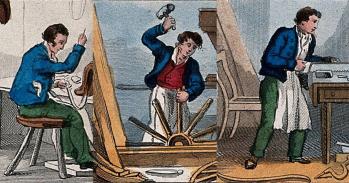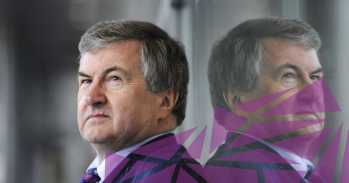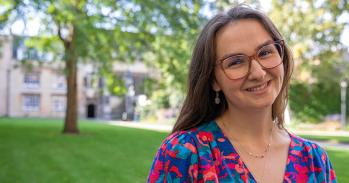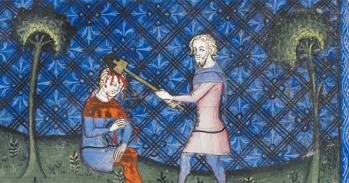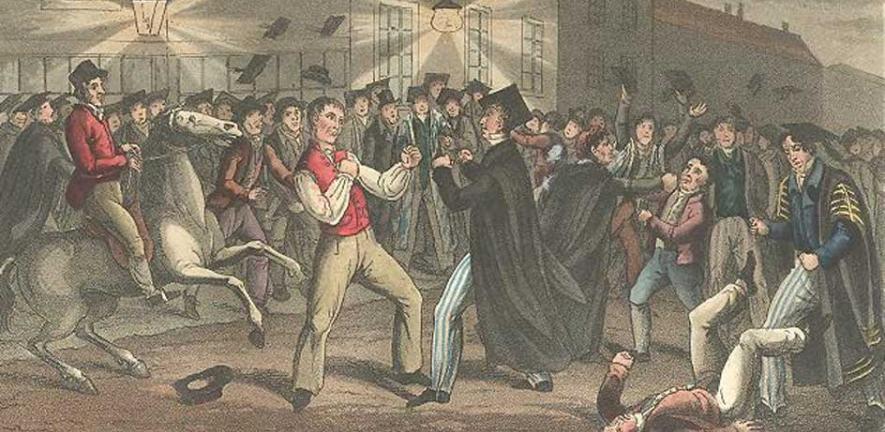
Bookings open today for Open Cambridge, a programme of public events taking place from 7 to 9 September. New activities on the agenda include a walk that focuses on death and disease, a chance to visit Queens’ College Library and a tour of historic swimming spots.
Bookings open today for Open Cambridge, a programme of public events taking place from 7 to 9 September. New activities on the agenda include a walk that focuses on death and disease, a chance to visit Queens’ College Library and a tour of historic swimming spots.
Magdalene Street, now home to chic shops, was once the city’s most notorious red light district.
A statue on the corner of St Michael's Court, close to the intersection of Rose Crescent and Trinity Street, commemorates the life of William Harvey. The first person to describe in detail the circulation of blood round the body, he is depicted holding a heart in his hand. On the opposite corner of the same building is a stone figure of Thomas Gresham, a financial wizard of his time. At the opposite side of Trinity Street, a series of busts decorate the façade of Gonville & Cauis College: they include the anatomist Francis Glisson, the chemist William Hyde Wollaston and several notable churchmen.
If you live or work in Cambridge it’s easy to take for granted the buildings and gardens you pass each day. In summer the throngs of tourists in the city are a reminder that Cambridge is a place renowned around the world for its extraordinary history, not just in terms of exceptional architecture but also as the cradle for ground-breaking research, generating breakthroughs in science and medicine that change lives and an understanding of arts and humanities that enrich society. Many of Cambridge’s ancient buildings are still used and lived in by students destined for exceptional careers.
The varied programme of Open Cambridge, a weekend of public events, is an opportunity to learn more about the city – both past and present – and the fascinating communities that made it what it is today. With the exception of a dinner at Corpus Christi College, the 50-plus events that make up Open Cambridge are free. Around two-thirds of the events require booking as numbers are restricted. Early booking is recommended as many events are likely to be highly popular.
The programme draws on the legacy of the town as well as the university. Among others, it offers the chance to take a guided tour of Mill Road Cemetery, enjoy a punt trip along the Backs with a Blue Badge Guide on board, and learn more about the creation of the gardens of Robinson, Newnham, Homerton and Lucy Cavendish (see programme for dates and details), to mention just a few of the Colleges opening their doors. Also open are the gardens of Madingley Hall (7 September), which look out over parkland where in the late 16th century the resident family hunted bears for sport.
The way in which town and gown interacted and tussled with each other in the turbulent medieval period makes a fascinating story told by historian Dr Rosemary Horrox. In her talk, A cuckoo in the nest? Medieval Cambridge and its University (8 September), she will look at the inevitable tensions between scholars and townspeople as the University and Colleges bought up increasing swathes of the town to build imposing buildings around spacious courts, demolishing streets of humbler dwellings in order to do so.
The bawdy carvings high up on the frontage of a 17th-century building opposite the entrance to Magdalene College are graphic evidence of the seamier side of the city. Magdalene Street, now home to chic shops, was once the city’s most notorious red light district. In his talk Crime in Cambridge past and present (8 September), criminologist Dr Michael Rice will take his audience right from the unrest of 1381 when the rioters looted the university to the current punt wars – and will touch on the rise of the CCTV camera and the debate surrounding crime-mapping.
In the 16th and 17th century the University was an extraordinarily powerful force well beyond the confines of the Colleges, with its proctors tasked with curtailing improper activities likely to have a negative impact on undergraduates within a five-mile radius of the town. Their powers included being able to arrest prostitutes and have them taken to a house of correction in St Andrew’s Street called the Spinning-House.
Today the city has one of the lowest crime rates in the UK, ranking 49th out of 54 cities. The exception is bike theft, a category in which Cambridge achieves a dubious first place with up to 3,000 stolen cycles reported to the police each year.
As in previous years, College libraries represent a strong feature in the Open Cambridge programme. The iconic Cambridge University Library (designed by Giles Gilbert Scott) is one of the world’s greatest research libraries, housing more than eight million books. College libraries opening their doors to the public include the Bodley Library at Christ’s College, St John’s College Old Library, the Parker Library at Corpus Christi, and the Old Library at Trinity Hall. There’s also a chance to see the much more modern libraries of the English Faculty and the Faculty of Modern and Medieval Languages. (See programme for all dates and details.)
The Senate House, which is open for a tour on 7 September, is in many ways a symbol of the University. Built in the mid-18th century from Portland stone, it is where all Cambridge students receive their degrees and celebrate with friends and families on the lawn outside.
Cambridge has long been associated with rowing and punting. It also has a strong tradition of swimming with generations of people learning to swim in the river upstream of the town. In his lyrical poem The Old Vicarage Rupert Brooke wrote of his longing for ‘the yet unacademic stream’ of the Cam making its lazy way through Grantchester Meadows and the ‘thrilling-sweet and rotten/Unforgettable, unforgotten/River smell’. The city’s hidden swimming history will be explored by Jean Perraton in a guided walk titled A dip into the swimming history of Cambridge (8 September).
An important part of Open Cambridge is the Bridge the Gap walk that raises substantial sums for local charities. It takes place from Jesus Green on 9 September and is enjoyed by more than 2,500 people. The route takes in many of the Cambridge Colleges as well as the historic city centre – and is designed to be family-friendly and accessible to wheel chairs.
For the 2012 Open Cambridge programme with full details of events, times and booking go to www.cam.ac.uk/opencambridge or phone 01223 766766.
This work is licensed under a Creative Commons Licence. If you use this content on your site please link back to this page.


